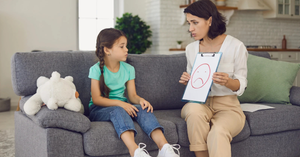"Mom, I'm hanging out with friends tonight!" your teenager announces, then heads to their room, closes the door, and spends the next three hours on their computer with headphones on. Sound familiar?
The playground meetups and mall hangouts that defined previous generations' childhoods have been replaced with Discord servers, group texts, and multiplayer games. As parents watch their children form relationships through screens rather than face-to-face interactions, many wonder: Is this healthy? Are these "real" friendships? Should I be concerned?
As a parent, there's nothing more concerning than seeing your child spend more and more time interacting with friends online rather than in person. Let's explore this situation together and find ways to support our children in developing a healthy balance between their online and offline social life.
What Does Social Life Mean for Our Kids?
For our children, social life is about forming connections, learning how to communicate effectively, and developing emotional intelligence. These skills are crucial for their future relationships, careers, and overall happiness. When they interact with friends in person, they learn important things like empathy, conflict resolution, and how to read non-verbal cues like body language and tone of voice.
However, what constitutes a "healthy" social life has evolved significantly in recent years. The pandemic accelerated the shift toward online socialization, and many children formed meaningful friendships through virtual platforms. For today's kids, the distinction between "online friends" and "real friends" isn't always clear-cut - both types of connections can feel equally valid and important.
Why Are Kids Socializing Online?
There are several reasons why children might prefer online social interactions:
Safety and Comfort
For many kids, online spaces feel safer. They can control their interactions, take time to respond, and present themselves exactly as they want to be seen. This can be especially appealing for children who:
- Experience social anxiety
- Have been bullied at school
- Feel different from their peers
- Are shy or introverted
Shared Interests
Online communities bring together people with similar hobbies and interests. A child who loves a particular game, book series, or creative activity might not find peers at school who share their passion but can connect with like-minded friends online.
Accessibility
Online friendships aren't limited by location or schedule. Kids can maintain these connections regardless of distance or busy after-school activities.
Signs Your Child's Social Life Is Primarily Online
How can parents tell if their child's social interactions have become exclusively virtual? Look for these indicators:
- They rarely mention in-person interactions with friends
- They turn down opportunities to participate in face-to-face activities
- They seem anxious or resistant when encouraged to socialize in person
- They spend most of their free time connected to devices
- Their mood seems heavily dependent on online interactions
- They express that they feel more understood by online friends
The Concerns of Exclusively Online Socializing
While online friendships can be valuable, an exclusively online social life may present challenges:
- Developmental Gaps: In-person interactions teach nuanced social skills that can't be fully replicated online. Reading body language, maintaining eye contact, handling unexpected social situations, and developing conversational flow happen naturally during face-to-face interactions.
- Physical Health: Hours spent on devices often mean less physical activity, less outdoor time, and fewer health benefits of active play.
- Safety Concerns: While online relationships are often genuine, they can sometimes involve deception or expose children to inappropriate content or behaviors.
- Limited Experience: Children who socialize primarily online might miss out on various social experiences that build confidence and adaptability.
Approaching the Situation with Understanding
Before taking action, it's crucial to understand why your child might prefer online socializing:
Have an Open Conversation
Ask your child about their online friends without judgment. Questions like "What do you enjoy about spending time with your online friends?" or "What kinds of things do you talk about?" can provide valuable insights.
Consider Their Perspective
Remember that for today's kids, online friendships are a normal part of growing up. Their generation doesn't always make the same distinctions between virtual and in-person connections that adults might.
Look for Underlying Issues
If your child avoids in-person socialization, try to understand why. Are they being bullied? Do they feel out of place? Are they struggling with social anxiety? Their preference for online interaction might be a symptom of these challenges.
Finding a Healthy Balance
Most parents agree that children benefit from both online and in-person social interactions. Here are ways to encourage a balanced social life:
Start Small
If your child is reluctant to socialize in person, begin with low-pressure situations. A one-on-one get-together with a compatible friend or a structured activity based on their interests can help build confidence.
Use Their Interests as a Bridge
Look for local clubs, classes, or events related to what your child enjoys online. A gaming tournament, anime convention, or coding class might connect them with like-minded peers in person.
Create Family Social Opportunities
Include your child in family social activities where they can practice face-to-face interaction in a supportive environment.
Set Reasonable Boundaries
Rather than banning online socialization, establish healthy limits. Designated device-free times and spaces can create opportunities for other types of interaction.
Model Balanced Behavior
Children learn by example. Demonstrate healthy social habits by balancing your own online and in-person connections.
When to Take More Direct Action
Sometimes, more intervention is needed if:
- Your child becomes extremely distressed when separated from devices
- Online interactions are clearly harming their mental health
- They're being exposed to inappropriate content or relationships
- Their schoolwork, sleep, or physical health is suffering significantly
In these cases, more structured limits may be necessary, even if they initially cause upset. Consider:
- Working with a family therapist who specializes in digital issues
- Gradually reducing screen time while increasing alternative activities
- Using parental controls while maintaining open communication about why
- Seeking help from school counselors if social difficulties extend to school
Finding Middle Ground
The goal isn't to eliminate online friendships but to ensure they're part of a varied social diet. When approaching your child about changes:
- Acknowledge the value of their online relationships
- Express specific concerns without criticizing
- Involve them in creating solutions
- Focus on adding positive in-person experiences rather than just restricting online time
Remember that forcing social interactions rarely works well. Instead, provide opportunities, encouragement, and support as your child expands their social horizons.
Conclusion
As a parent, it's natural to worry about your child's social life. By understanding their needs and working together, you can help them develop a healthy balance between online and offline connections.








Be the first one to comment on this story.